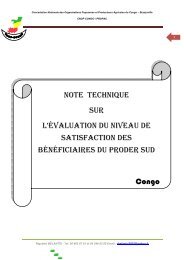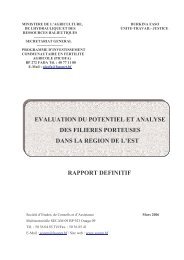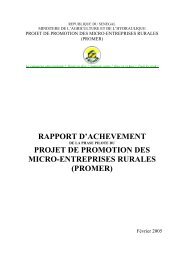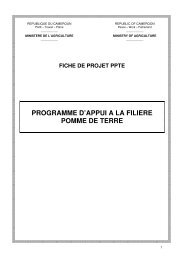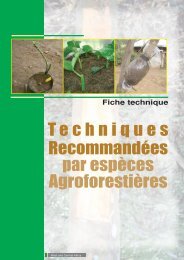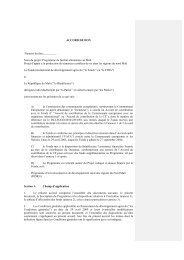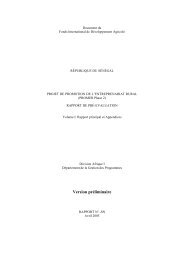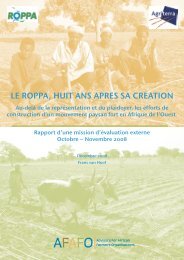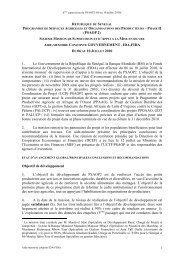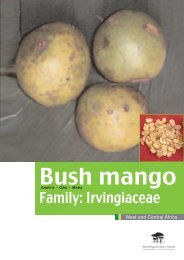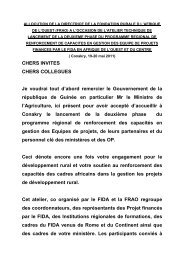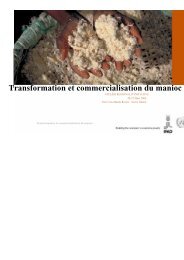Scaling Up the Fight Against Rural Poverty - FIDAfrique
Scaling Up the Fight Against Rural Poverty - FIDAfrique
Scaling Up the Fight Against Rural Poverty - FIDAfrique
Create successful ePaper yourself
Turn your PDF publications into a flip-book with our unique Google optimized e-Paper software.
• focusing on management of productive natural resources through <strong>the</strong> use of a competitionbased<br />
approach known as “Pacha Mama Raymi” (MARENASS); and<br />
• expanding <strong>the</strong> scope of projects by fur<strong>the</strong>ring <strong>the</strong> concept of socio economic development<br />
corridors, recognizing <strong>the</strong> relevance of urban-rural linkages, <strong>the</strong> importance of micro<br />
enterprises activities and <strong>the</strong> need to foster business opportunities and <strong>the</strong> development of<br />
local markets for goods and services (CORREDOR).<br />
Innovation in <strong>the</strong> MARENASS project was understood as a series of concepts, criteria and instruments<br />
that <strong>the</strong> Government of Peru and IFAD implemented systematically at a considerable scale over time,<br />
in a large area, with significant resources and in a way that was novel in Latin America. The design of<br />
this project syn<strong>the</strong>sized o<strong>the</strong>r fragmented and incomplete previous experiences.<br />
FEAS continued and deepened <strong>the</strong> approach of MARENASS, while <strong>the</strong> CORREDOR project<br />
replicated successful practices from FEAS and MARENASS, expanded <strong>the</strong> geographical coverage in<br />
<strong>the</strong> Sou<strong>the</strong>rn highlands and included an initiative to add value to beneficiaries’ assets by including <strong>the</strong><br />
identification of market potential for products with a traditional cultural content. Additionally a pilot<br />
program to promote savings among rural poor women was introduced in <strong>the</strong> context of a sub<br />
component to enhance financial markets.<br />
In <strong>the</strong> SIERRA SUR project, <strong>the</strong> accumulated experience and tried innovations introduced in<br />
predecessor projects are being deepened in pursuit of enhanced impact. The recently launched<br />
SIERRA NORTE project will fur<strong>the</strong>r expand coverage and test approaches in a similar geographical<br />
setting but with distinct social organizational structures.<br />
b) <strong>Scaling</strong>-up pathway – a multi-dimensional approach<br />
In <strong>the</strong> Peru country program <strong>the</strong> sequence of IFAD projects involved a multi-dimensional scaling up<br />
approach: scaling up occurred within sectors and across sectors; within geographical areas and beyond;<br />
across stakeholders; and with multiple institutions.<br />
• Sectorally, <strong>the</strong> starting point was <strong>the</strong> agriculture sector in MARENASS. Its competitions<br />
(‘concursos’) addressed communal rangeland management and smallholder irrigation. Followup<br />
projects covered all agriculture, with <strong>the</strong> more recent ones also addressing rural<br />
development and housing. This process of “functional scaling up” culminated under <strong>the</strong><br />
CORREDOR project by fostering urban-rural linkages formalized through business plans for<br />
private asset accrual. A new IFAD project, currently under preparation (“Consolidating<br />
Innovations in <strong>the</strong> Highlands”) now seeks to combine a rural development approach with a<br />
territorial development approach. This would be embedded at municipal levels and would aim<br />
to offer opportunities to private business growth that may or not be agriculture-based (e.g., by<br />
delivering public utilities such as water and power to small enterprises or tourist facilities).<br />
• Geographically, IFAD’s projects initially focused on selected areas of <strong>the</strong> Sou<strong>the</strong>rn highlands<br />
of Peru and gradually expanded coverage within this region. In its most recent project IFAD<br />
expanded its engagement to <strong>the</strong> Nor<strong>the</strong>rn highlands.<br />
• As regards beneficiaries or clients, IFAD designs initially focused on smallholder farmers,<br />
while later defining its target group as farmers (“campesinos”) more generally and finally<br />
addressing rural “citizens”. 10 These shifts mirror <strong>the</strong> changes from <strong>the</strong> restricted agricultural<br />
development perspective to a more holistic, inclusive concept of streng<strong>the</strong>ning local capacities<br />
10 The shifting definitions respond to emphasis in approaches. ‘Campesino’ has a different connotation in Peru<br />
and Latin America than small-scale farmers as it refers to a livelihood strategy which is more encompassing than<br />
<strong>the</strong> pure agricultural activity of a small farmer. The use of a citizen categorization takes into account that target<br />
groups are not simple beneficiaries but are individuals and families with right and obligations.<br />
16



